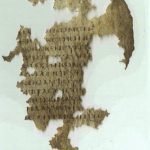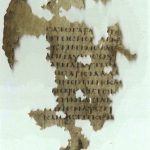| Artefact ID | 503 |
| TM ID | TM 64493 |
| Findspot (DEChriM ID) | 23 (al-Šayḫ ʿIbāda) | Class | Textual |
| Material | Parchment |
| Writing medium | Codex |
| Text content | Literary |
| Language | Greek |
| Description | P.Ant. I 13 A parchment fragment from a miniature codex containing the Acts of Paul and Thecla 2-3. The small fragment (7.2 x 8.7 cm) preserves a folio from a miniature codex. There are 11 lines per page, with approx. 11 letters per line. The ed. pr. estimates that the complete Actes of Paul and Thecla would require 100 pages of this format; see ed. pr. The script is an upright uncial written by a trained hand, and gives a formal impression; see Wayment 2013: 20. Line-final nu is appreviated by a horizontal stroke, and there is one nomen sacrum (see πν(εύματ)ι in l. 18, verso). Wayment points out that this abbreviation is somewhat curious, given that it refers to the spirit of a person, rather than the Holy Spirit. Punctuation is expressed by high points, and there are no marked breathings. |
| Selection criteria | Literary genre (Non-canonical), Nomina sacra |
| Date from | 375 |
| Date to | 450 |
| Dating criteria | Palaeography. The listed date was proposed by the ed. pr. More recently, the fragment was dated to the beginning of the 5th c. in a letter by the palaeographer Pasquale Orsini. |
| Absolute/relative date | Relative date |
| Archaeological context | The fragment was discovered in al-Šayḫ ʿIbāda (Antinoopolis). |
| Accession number | Oxford, Sackler Library, Papyrology Rooms, P.Ant. 13. |


 Json data
Json data





